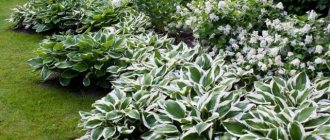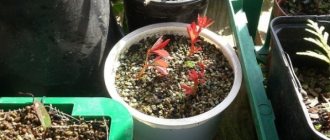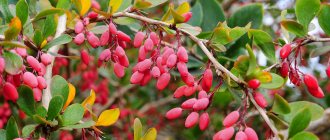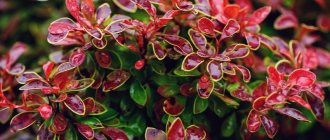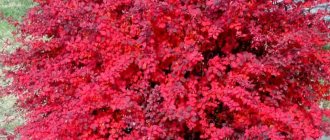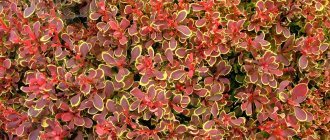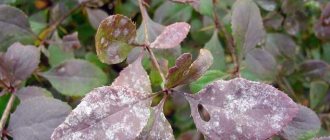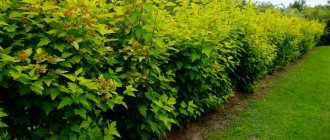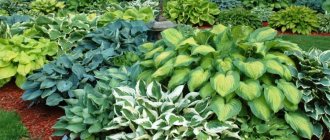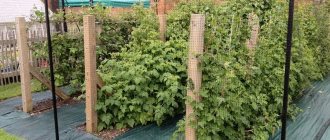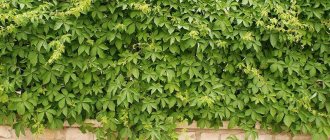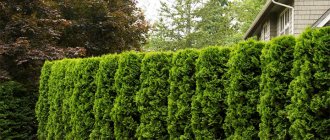Barberry (Berberis) is suitable for creating beautiful and reliable hedges. Both tall and low, plain and with varied leaf colors. Barberry would be good for everyone, if not for a number of “disadvantages” that should be taken into account.
I saw how people dug up absolutely healthy barberry bushes and planted other shrubs in their place. The people around watched this with interest and some bewilderment. About eight years ago I had to do exactly the same thing. First, I grew several huge, spreading bushes planted in one row, admired them, and then uprooted them. This was not a momentary weakness, but a completely reasonable decision by all family members.
No one will be able to get into the plot through such a thick hedge of thorny barberry.
Advantages of a barberry hedge
A living, self-renewing barberry fence is 5-10 times more durable than wooden fences and fences, several times cheaper than corrugated fences, and more functional than chain-link mesh:
- grows quickly: in 1.5 - 2 years you will get a dense, high (about 1.5 m) hedge;
- will live 50 years or more;
- growing, it forms solid walls, “armed” with sharp spikes up to 1 cm long;
- does not require complex care: it is enough to feed it with complex fertilizer 1 – 2 times a summer;
- it is easy to trim with any hand tool, it can be given any shape, you just need to protect your hands from thorns with thick (canvas) gloves;
- available in dozens of options - green, red, variegated, gold, silver and many combinations thereof.
A barberry fence will not clog the area: the rhizomes of the bush do not spread around, only the seeds germinate, but they are easily removed with ordinary weeding.
What types of barberry are used for landscape design?
Barberry "Ordinary"
This variety is recognized by gardeners as the easiest and most unpretentious to care for. But, despite this, photos of decorative barberry allow you to appreciate all its beauty. In April, the bush is covered with delicate flowers, which add beauty and unsurpassed beauty to the plant. In autumn, barberry bears fruit. Small oval berries of bright red color perfectly dilute the array of greenery. This barberry variety is frost-resistant and tolerates drought and waterlogging. It takes root well after transplantation even in poor soil.
If you need a high barberry hedge, it is recommended to purchase the “Ordinary” variety. The shrub reaches a height of 2 and sometimes 2.5 meters.
Barberry "Thunberg"
Many gardeners choose the Thunberg variety for planting barberry. This is due to the fact that the shrub is not only unpretentious in care, but is also distinguished by its enormous diversity. The variety is divided into several subspecies, each of which is distinguished not only by the height of the bushes, but also by the range of color leaves. Barberry "Thunberg" bears fruit with small berries, which play only a decorative role.
The fruits of the barberry "Thunberg" cannot be used for food. They contain large amounts of alkaloids, which makes them bitter in taste and inedible.
Barberry "Ottawa"
This variety is a hybrid, as it was bred by crossing the “Ordinary” and “Thunberg” barberries. The homeland of the bush is Canada. Planting barberry "Ottawa" is possible in conditions of low temperatures, since the variety has a high degree of frost resistance. The shrub has a unique color scheme. In spring and summer, the leaves acquire a beautiful purple color. In autumn, the foliage turns orange, red and yellow. The plant bears fruit. The berries remain on the branches throughout the fall, which adds brightness and beauty to the bush. Barberry "Ottawa" reaches a height of 3 meters. The branches are very soft, since thorns are almost completely absent.
Barberry "Amur"
The shrub was bred in the Khabarovsk Territory. Ideal for planting both in the Far East and in the central part of Russia. The shrub is distinguished by large foliage of bright green color. In autumn, the leaves take on a burgundy hue. The spines of this variety of barberry reach a length of 3 cm. That is why the species is considered the best option for creating protective hedges.
Barberry "Amur" bears fruit in the autumn. However, it is worth remembering that unripe berries are poisonous. Only ripened fruits can be eaten.
Features of varieties
According to various sources, there are about 150 cultivated varieties of barberry. 20 are actively cultivated, in Russia 10, and dacha barberry is represented by 4 universal, very hardy species - we will talk about them below.
Among the varieties there are deciduous and evergreen, very thorny and non-thorny, heat-loving and frost-resistant. Thus, B. asiatica is very unpretentious, does not freeze, but its leaves are pure green, which reduces its decorative value. And B. oblong is good for everyone, but grows slowly, blooms from 5 years. B. whole-edged and Turkmen are decorative, but they begin to bloom even later - from 7 to 8 years. The evergreen B. verrucosa is a very beautiful plant native to China, but will only survive in warm regions in southern Russia.
Most varieties have yellow flowers, reminiscent of bells, collected in clusters of 5 - 10... 20. Shrubs bloom for a long time, 2 - 3 weeks, many varieties are honey plants - and have a pleasant sweetish aroma.
The most important characteristics when choosing plants for a hedge are leaf color and height. Depending on the tasks and weather conditions, you can plant dwarfs up to 30 cm high and giants up to 4 m, green and colorful plants.
Bushes growing in the shade change the color of the leaves to a weak one, with a predominance of green.
Most barberry varieties grow quickly. With minimal feeding - during planting and 1-2 times during the summer with complex fertilizer - the bushes grow in a year and a half to 1.5 m in height, and after 2 years they turn into a full-fledged hedge.
Barberry is easily affected by powdery mildew. At the first sign of it, treat the bushes with Topaz, Vectra, Skor, TiovitJet, Topsin or mullein infusion mixed with soda ash (a handful per 10 liters of solution).
Another enemy of the plant is rust. When it appears, treat the bushes with Abiga Peak or Bordeaux mixture. A 1% solution of colloidal sulfur helps well against both ailments. To prevent infection, you need to spray at the moment the leaves bloom and 2 more times with an interval of 20 days.
Choosing a shrub for a hedge
Next, we will talk about four universal types of barberry - beautiful, winter- and heat-resistant, well tolerant of drought, waterlogging, and poor soil.
Common barberries, Thunberga, Amur and Ottawa barberries will delight even novice summer gardeners; they can be easily formed into hedges of varying heights and decorativeness.
Common barberry
The common barberry is used for hedges more often than others in all regions of Russia except the Far North. The reason is its resistance to frost, drought, waterlogging, poor soil, and at the same time it is good decorative. Common varieties are Atropurpurea with red leaves and Albo-variegata, which has white stripes and spots on the leaves.
Without pruning, the shrub grows up to 2.5 m in height, and under favorable conditions - up to 3 m. The crown has a rounded, dense crown. Young branches are yellowish, purple, and with age they become grayish-white.
The decorative appearance of the common barberry is characterized as modest, but the definition “elegant” is more suitable for it. The shrub has small serrated leaves and during flowering produces yellow flowers about 1 cm in diameter, collected in clusters of an average of 20 flowers. Barberry blooms profusely during 3 spring weeks (April - May).
But barberry plantings and bushes are especially beautiful in the fall, when they are covered with bright red oblong fruits. By this time, the leaves also acquire a bright shade, adding color to the landscape. If desired, the berries can be collected, made into compote, tinctures and liqueurs, jam, or dried to be used as a seasoning for meat, pilaf, and stew.
Amur barberry
This type of barberry is quite resistant to drought, frost and heat, and therefore is cultivated throughout Russia. In favorable conditions it grows up to 3.5 m, throwing out straight yellowish shoots that become gray with age.
Amur barberry, like ordinary barberry, is very beautiful in autumn: the leaves, collected in bunches, acquire a purple, fiery color - the bushes seem to be on fire. In spring, the shrub blooms for about 20 days with pale yellow, cream flowers with a strong, intoxicating aroma. For this reason, beekeepers love it very much: barberry honey has a unique bright aroma, and the plant itself is an excellent honey plant.
All parts of Amur barberry - roots, branches, leaves, berries, flowers - have medicinal properties. Therefore, trimming hedges turns into harvesting useful raw materials.
Barberry Thunberg
This type of barberry is distinguished by the bright red, orange color of its young shoots, which become brownish-red or red-brown with age. The branches of the bush deviate and “hang down.” The height of the bush is up to 2.5 m.
The plant is frost-resistant, unpretentious, and therefore is cultivated everywhere except the Far North. In spring, the bushes bloom for 3 weeks with yellow, slightly red flowers on the outside - single or collected in small (up to 5 flowers) clusters. In autumn, bright red, scarlet fruits ripen, and the foliage of many varieties becomes carmine red with a deep purple tint.
One of the most expensive and decorative varieties of the species is Bagatelle. The plant is up to 40 cm tall and has a dense crown diameter of 40 cm, similar to a bronze-red ball. Other dwarfs of this species are the green Kobold (up to 50 cm), the lemon-golden BonanzaGold, and the purple, almost thornless Atropurpurea.
The taller one is up to 1 m, while the yellow variety is Aurea. It is so bright that it seems like the sun is always shining on it. PinkQuenn has pink foliage, SilverBeauty has silver-variegated foliage.
This shrub was bred artificially in Canada (Ottawa), by crossing the Thunberg barberry and the common barberry. The Purpurea variety with dark purple, almost black in the sun leaves is especially popular in Russian areas. The SilverMiles variety is very decorative: its beet-colored leaves are “painted” with silvery, pinkish “brush strokes.”
Varietal bushes grow up to 2m high. The Ottawa variety differs from natural species in having a few soft thorns and brighter foliage color.
In April-May, yellow-red flowers appear on the bushes, collected in clusters of 5-10. Even the young foliage is purple, dark red with a bluish tint, which is very impressive in combination with yellow flowers. In autumn the leaves turn bright red and orange.
Why barberry?
Let's move on to the hero of our story. And why, in fact, barberry? How did he deserve such an honor and what are his advantages over other contenders for creating a green hedge?
Let's start from a distance, that is, by considering the very essence of barberry. It is mostly a southerner, the number of its species amounts to more than one hundred. Of course, for breeders this is a real green field for work. So they create more and more new varieties, differing from each other in the shape of the leaves, their colors and adaptability to different natural conditions. Not all barberry varieties are heat-loving sissies; among them there are quite hardened ones that can grow with no less success in our climate zone. And if so, barberry can reveal its best qualities here.
Barberry is unusually decorative, and some of its varieties grow edible berries.
The first feature is the resistance of some varieties of barberry to the harsh conditions of our strip. Neither summer heat nor winter cold will stop it from delighting you with its beautiful greenery. Moreover, you can choose a variety that is better adapted to life in the shade or vice versa - in a sunny place.
Thanks to the variety of colors, barberry significantly diversifies the appearance of a garden plot.
The variety of varieties allows you to count on a variety of leaf colors. The leaves can be double or smooth; in the spring the bush is covered with a carpet of pleasantly smelling flowers, and by autumn it changes colors, adding ripening berries. These berries can remain on the bushes in winter, which will also add variety to the appearance of the area.
Barberry is an excellent living defender against the encroachment of strangers on your site - its thorns, reaching up to three centimeters in length, will not allow you to break through the dense jungle of bushes. If only bypassing.
Barberry propagates well both by seeds and by cuttings and layering. The variety of varieties allows you to choose in advance the height of the future hedge. It varies from 0.5 m to 2.5 m.
Shrub propagation
Barberry is propagated by seeds, cuttings, layering, and dividing bushes.
If you grow a plant from a seed, remember that its properties may differ, sometimes significantly, from the mother bush.
Seeds
It is more successful to sow seeds in the ground in the fall. You need to make furrows up to 3 cm deep, fill the bottom with sand, put seeds and cover with a layer of mulch, preferably sawdust.
You can only use sawdust that has been rotted or scalded with boiling water to prevent acidification of the soil and fermentation processes.
When the snow melts, to speed up the process, cover the bed with film. The seeds will not sprout soon, but together: out of 10, about 7.
If you sow in spring, the seeds will have to be stratified. They are placed in sifted sand and put in the refrigerator, on the vegetable shelf, for 4 months. In the spring, containers with seeds are taken out, the sand is moistened and they wait for germination. With the first true (not cotyledon) leaf, the plant is planted in a protected place. For the winter, grown bushes are covered with spruce branches, non-woven protective material and other methods.
Cuttings
Cuttings are cut from annual lignified branches about 20 cm long, with 5–6 internodes. It is better to do this in the spring, because the branches cut in the fall will have to be stored in the refrigerator in damp sand.
Root the cuttings in moist soil, preferably in a greenhouse. The branch is placed vertically, leaving 2–3 buds or leaves on the surface. The lower part of the branch that ends up in the ground must be cleared of leaves and buds.
By layering
In the spring, strong, usually annual, branches are bent to the ground into a pre-dug ditch, sprinkled with earth, and secured with a wooden or wire pin.
In the fall, when the branch has taken root, it is cut off from the bush and transplanted to a new place.
Reproduction by layering is used to create an impenetrable fence. To do this, for each grown bush, 1 branch is rooted in the space between the plants.
“Disadvantages” of barberry, which are better to know about in advance
When I planted barberry bushes, I couldn’t even imagine how easily it catches powdery mildew, becomes covered with a white coating and itself becomes a source of infection. Because of this, I had to replant the luxurious phlox immediately. Barberry is also known to be prone to rust. It even affects seedlings.
Powdery mildew disfigures the plant
Barberry is a terrible weed. Its seedlings will appear everywhere. They will find gaps between paving slabs and paving stones. They will establish themselves on any tiny piece of land and sprout under bushes. These seedlings need to be removed as early as possible, before their strong, long roots go deep into the ground.
And how I suffered because of the hard, sharp thorns, about 2 cm long. Because of them, barberry care was reduced to a minimum, which did not prevent the shrub from feeling great. Pruning such thorny bushes may seem like a real punishment. Especially the removal of dry and old branches located deep in the crown. Safety glasses and leather gloves only saved the eyes and hands, but not the rest of the body and clothing.
Hard and sharp barberry spines are a formidable weapon
Landing Features
The favorable time is autumn, but spring is also suitable, provided that the bushes are regularly watered.
Plants of different sizes use different planting schemes.
For medium/tall barberries, the distance between the bushes:
- when planting in 1 row - 60 - 80 cm;
- when planting in 2 rows - 80 - 100 cm;
- the distance between the rows is 50–60 cm, the bushes in the rows are placed in a checkerboard pattern.
For low-growing barberries, the distance between bushes:
- when planting in 1 row - 50 cm;
- when planting in 2 - 3 rows - 40 cm;
- the distance between the rows is 40–50 cm, the bushes in the rows are placed in a checkerboard pattern.
The holes need to be dug of such a diameter and depth that the roots can be placed in them freely. At the bottom of the pit put (per 1 sq.m.) 250 g of lime, 20 g of superphosphate, 10 g of potassium salt and up to 10 kg of compost. Fertilizers are sprinkled on the soil on which the roots are placed.
Before planting, the roots are inspected, rotten, dried and very long ones are removed/cut.
The plant is not placed in a hole, but “suspended” in the hand so that the roots are positioned freely. With the other hand they are covered with soil - this way they get a natural arrangement of the roots and maintain their integrity.
When the roots are covered, the soil is carefully compacted and watered generously. Lay mulch on top - straw, grass, spruce branches.
If you are using plants from a nursery, follow the planting steps shown in the picture.
Immediately after planting, the plants are cut back by about 1/3 of the shoot - this way they will take root better and immediately begin to grow in breadth and height. To cut evenly, you need to stretch a thread or rope along the fence at the desired height.
Care and pruning
In the first summer after planting, a barberry hedge needs watering: for a 3-year-old seedling - about 8 liters (bush), for a 2-year-old - 4 - 5 liters (bush) per week or as it dries out. Mulching significantly reduces watering; it also saves the soil from excessive density and excess salts.
In subsequent years, water the hedge only in case of drought or when applying fertilizers. It is better to feed the planting with complex fertilizers at the beginning of the growing season and before winter, in August-September.
Pruning to form a height and a simple crown is carried out in June and August, when forming complex shapes - more often (if necessary). In the spring, in addition, you need to cut out all the old, diseased, dried branches. Barberry tolerates pruning of one-year-old and new branches very well, so the owner of the property, with effort and patience, will be able to create a real work of art from the hedge.
